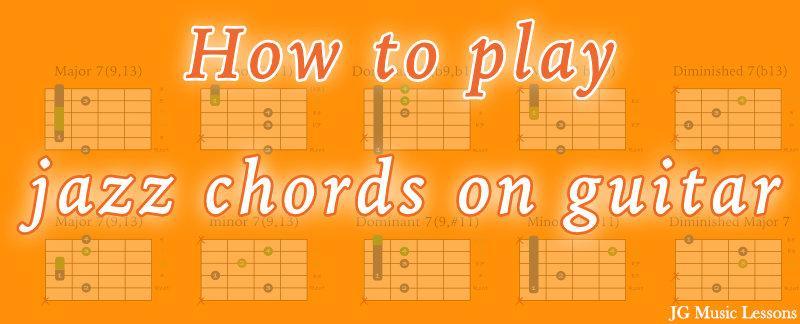If you’ve tried learning to play jazz chords on guitar, it can feel overwhelming understand what they are or how they work. In this lesson, we’ll break down the theory on how jazz chords are formed, cover over 70 jazz chord shapes on guitar and look at chord progressions examples help you apply them.
Once you learn the movable jazz chord shapes included in this lesson, you can shift them to any root note. Grab your guitar and let’s get started!
Understanding jazz chords and chord extensions
Jazz chords are formed by adding chord tones to basic triad chord structures. You can think of a chord tone as a scale degree in relation to the root note.
First, let’s look at what chord tones belong to triad chord structures below.
- Major chord – 1, 3, 5. For example, C Major has the notes C, E, and G.
- minor chord – 1, b3, 5. For example, C minor has the notes C, Eb, and G.
- Diminished chord – 1, b3, b5. For example, C diminished has the notes C, Eb, and Gb.
- Augmented chord – 1, 3, #5. For example, C augmented has the notes C, E, and G#.
If we take this one step further and add another note to the basic structure we get 6th and 7th chords such as:
- Major 6 chord – 1, 3, 5, 6. Example: C Major 6 has the notes C, E, G, and A.
- Minor 6 chord – 1, b3, 5, 6. Example: C minor 6 has the notes C, Eb, G, and A.
- Major 7 chord – 1, 3, 5, 7. Example: C Major 7 has the notes C, E, G, and B.
- Dominant 7 chord – 1, 3, 5, b7. Example: C 7 has the notes C, E, G, and Bb.
- Minor 7 chord – 1, b3, 5, b7. Example: C minor 7 has the notes C, Eb, G, and Bb.
- Minor 7 b5 chord – 1, b3, b5, b7. Example: C minor 7 b5 has the notes C, Eb, Gb, and Bb.
- Diminished 7 chord – 1, b3, b5, bb7 (same as Major 6). Example: C diminished 7 has the notes C, Eb, Gb, and A.
Jazz chords often include the 6th or 7th chord tone with upper chord extensions such as the 9th, 11th, and 13th to more color to a chord.
- Major 7 (9) – 1, 3, 5, 7, 9. Example: C Major 7 (9) has the notes C, E, G, B, and D.
- Major 7 (9, #11) – 1, 3, 5, 7, 9, #11. Example: C Major 7 (9, #11) has the notes C, E, G, B, D, and F#.
- Major 7 (9, #11, 13) – 1, 3, 5, 7, 9, #11, 13. Example: C Major 7 (9, #11, 13) has the notes C, E, G, B, D, F# and A.
You can also apply these upper chord extensions with other chord qualities such the Dominant 7th or minor 7th chord. For example, C 7(9) or C minor 7(9).
Note that if the 7th chord tone isn’t implied in a chord, the added notes are typically called differently. For example, without the 7th chord tone, you would say 2 instead of 9, 4 instead of 11, or 6 instead of 13. Chord names are often used interchangeably but it will help to understand this concept of upper chord extensions.
Keep in mind that not all the chord tones are included in a chord shape since it’s impractical and sometimes impossible to add all the notes at once. Usually, some notes are omitted to play these on these chords on guitar.
7th chords
Before we get into the different upper chord extensions, it would be beneficial to review 7th chord shapes starting on different strings.
To clarify how to read the chord charts, the top horizontal line represents the high E string and the bottom horizontal line represents the low E string. The vertical lines separate each fret. The numbers in the blue dots tell you which fingers to use on the fretting hand. You can check this link for more on how to read guitar notation symbols.
In the charts below, the numbers on the right represent the chord tones related to the root note. All the shapes are movable shapes which you can apply to on any root note. You can adjust the fingerings if any strings include open strings on a certain chord.
7th chords starting on the 6th string

7th chords starting on the 5th string
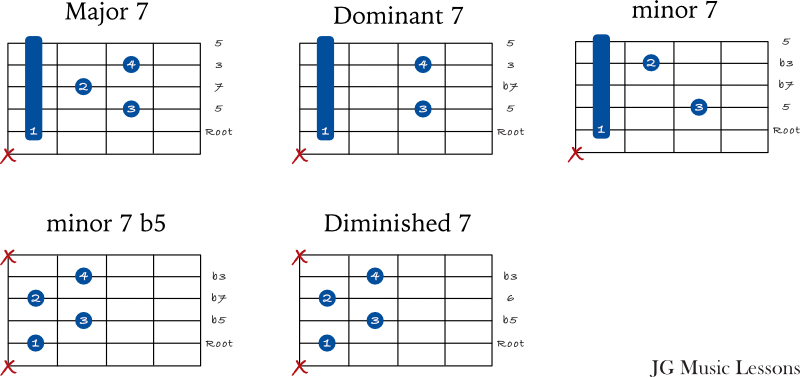
Major 7 chord extensions
Now that we’ve covered 7th chords, we’ll also learn other chord variations including upper chord extensions such as the 9, 11, and 13.
The green colored areas and numbers represent the upper chord extensions.
Major 7 chord extensions starting on the 6th string

Major 7 chord extensions starting on the 5th string
Note that Major chords with the 13 and 9 chord extensions are sometimes called “6/9 chords”. For example, you would write C 6/9.
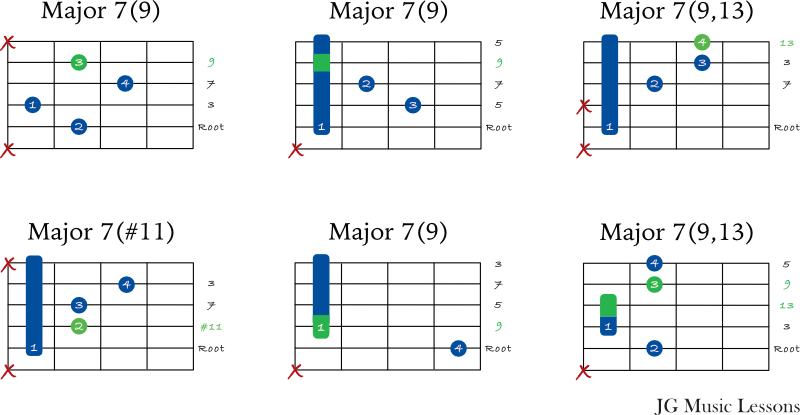
Another chord that is closely related to the Major 7 is the Major 6 chord. See this other lesson to learn how to play Major 6 chords on guitar.
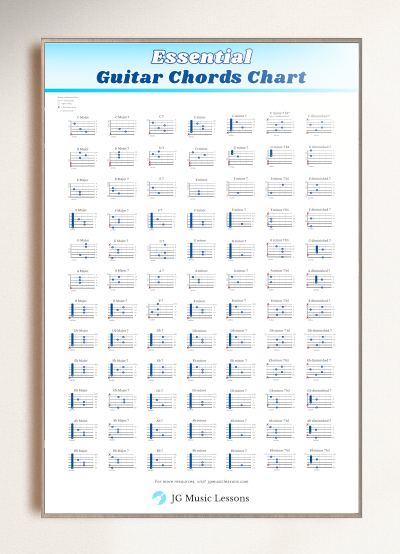
Dominant 7 chord extensions
Dominant chord extensions starting on the 6th string
The chord charts below also include altered chords which means broadly means any Dominant 7 chord with sharp or flat upper extensions such as b9, #9, #11, or b13. You could use the altered scale over altered chords.

Dominant chord extensions starting on the 5th string
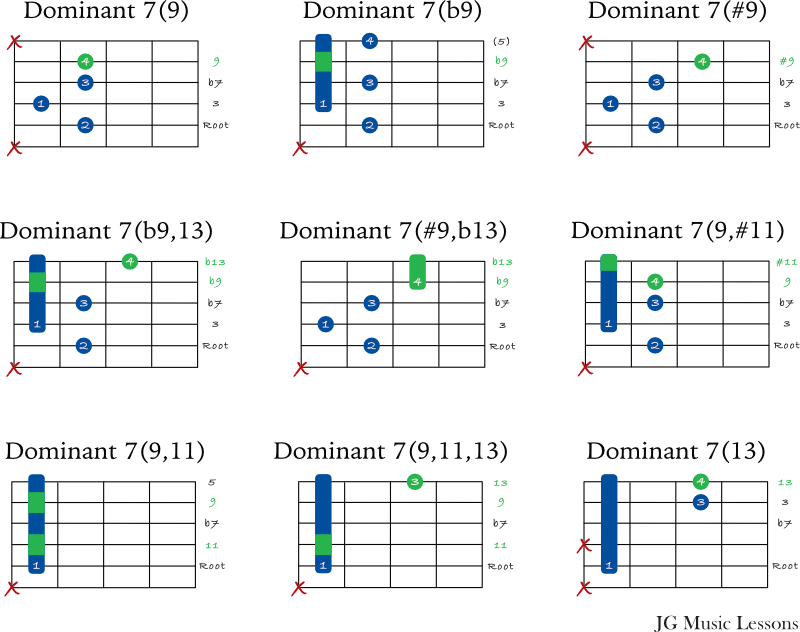
Minor 7 chord extensions
Minor chord extensions starting on the 6th string
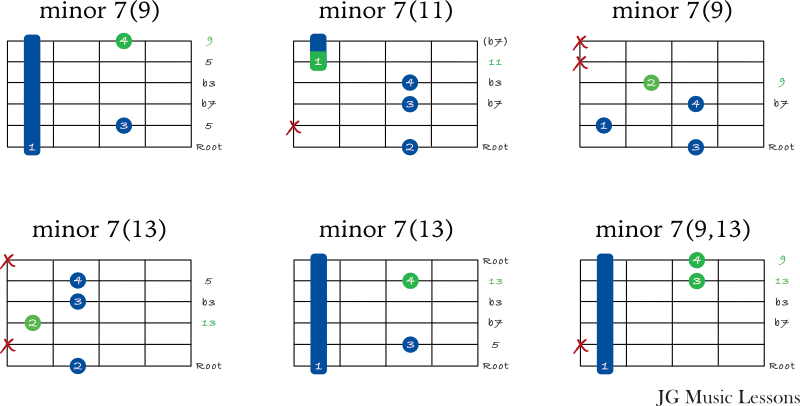
Minor chord extensions starting on the 5th string
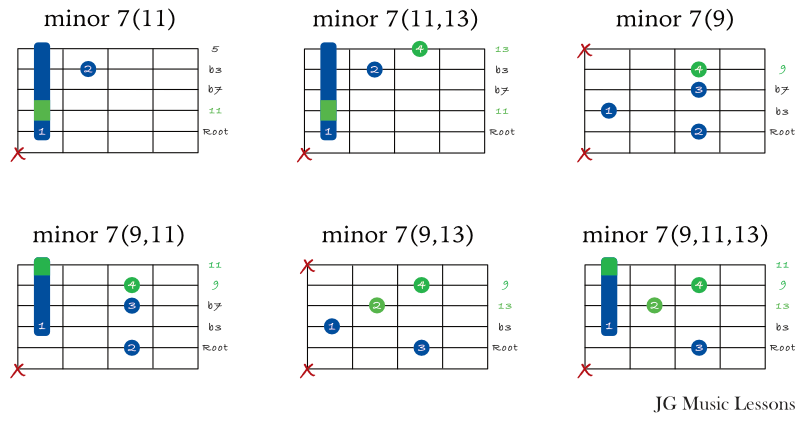
Half diminished chord extensions
If you don’t these chords yet, see how to play half diminished chords (aka minor 7 b5) here.
Half diminished chord extensions starting on the 6th string
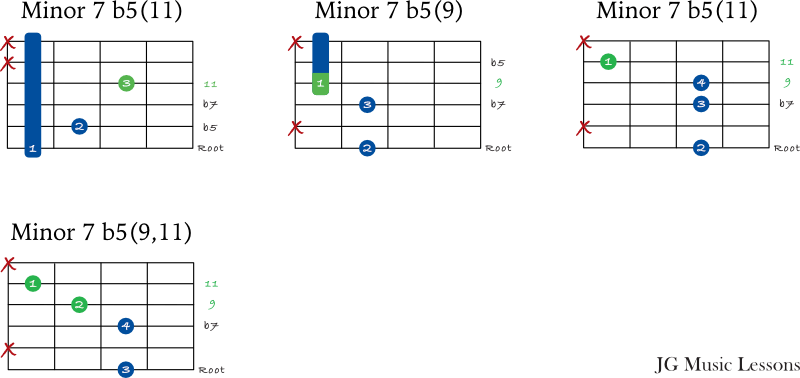
Half diminished chord extensions starting on the 5th string
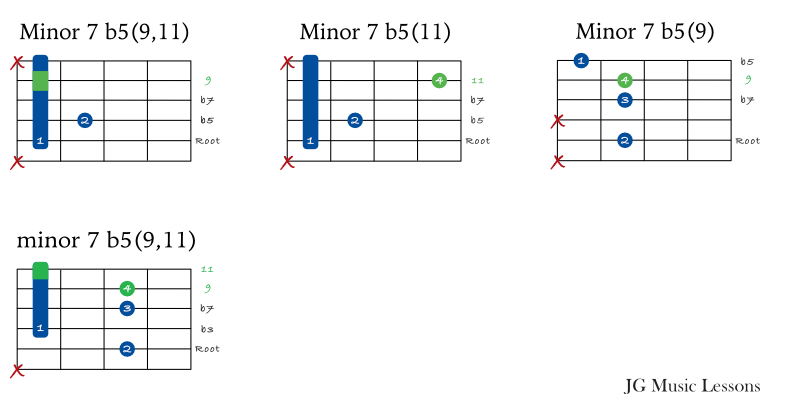
Fully diminished chord extensions
For diminished 7 chords, we’ll consider the Major 7 as a chord extension since the original chord tones are 1, b3, b5, and 6 (also referred to as bb7, or double flat 7). The following chord variations might be less commonly known but are still helpful to add here for reference.
Diminished 7 chord extensions starting on the 6th string
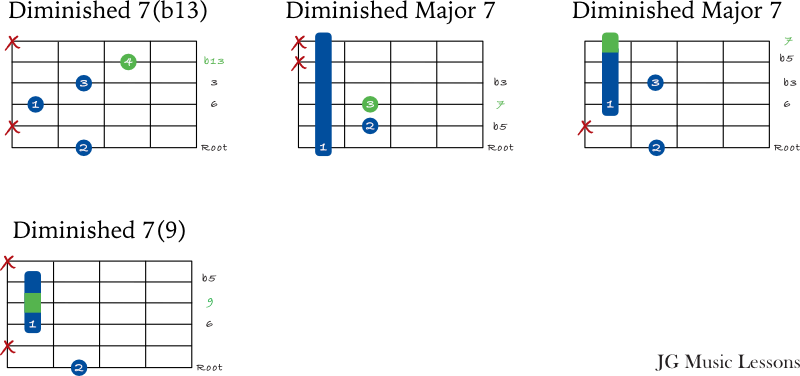
Diminished 7 chord extensions starting on the 5th string

Jazz chord progressions on guitar
Here are 6 examples of jazz chord progressions using mostly chords with upper extensions including guitar tabs. The numbers next to the notes on the top staff are fingering suggestions for your fretting hand. If needed, you can refer back to the chord charts to help you play a certain chord shape.
Jazz chord progression 1

Jazz chord progression 2

Jazz chord progression 3

Jazz chord progression 4

Jazz chord progression 5

Jazz chord progression 6

Wrapping up
There are many more variations to play these chords such as using rootless voicings, drop 2, or drop 3 chords or starting on the 4th string. However, learning the chords in this lesson will give you a solid foundation to play many essential jazz chord shapes on guitar.
To create other jazz chord variations, I also recommend learning shell chords, which are simplified structures highlighting the important notes in a chord. From there, you can add more notes that complement a chord structures.
Experiment with these rich sounds and save the ones that stand out to you. Overtime, you will build a wider chord vocubulary which you can use for different musical situations.
📘 Get the free guitar practice guide here!
Best,
JG Music Lessons
📙 Kickstart your guitar playing with our step by step guide: Guitar Essentials.
🎸 Looking for a travel or half-sized guitar? See this one.
🛠 See our other music recommendations.
🤝 Support the site to help us to create better content for you!
Level up with the FREE guitar practice guide and effectively improve your playing! 🎸
Get it sent to your email!

